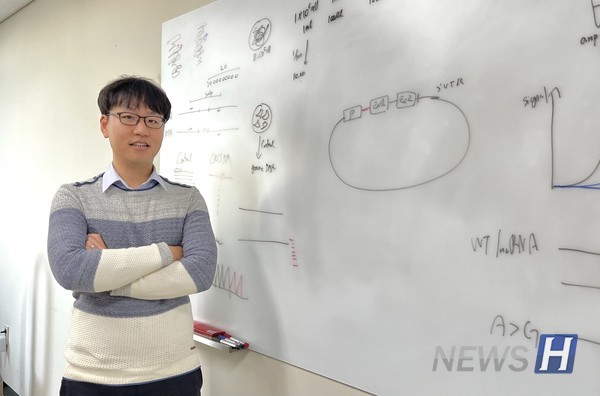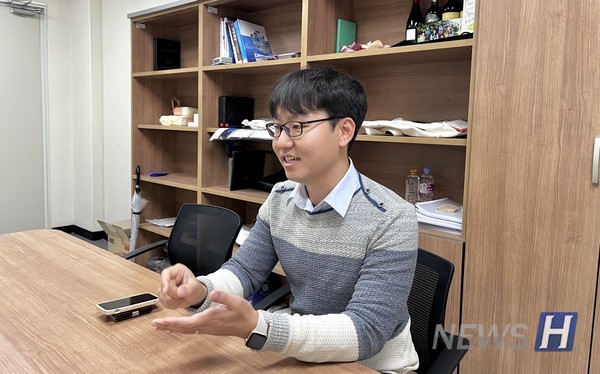- Development of new technology to derive cancer mutation characteristics
- Research results combining various cutting-edge biotechnologies
- Expected to be valuable in patient-tailored cancer treatment and new drug development
Cancer is the leading cause of death among Koreans. According to YTN Science, the annual incidence of new cancer cases recently exceeded 79 percent for the first time in 30 years. Consequently, the number of cases of harm caused by cancer is on the rise. However, the challenge of precise cancer treatment persists due to the inability to analyze the numerous mutations present in human genes.
Professor Kim Heon-seok of the Department of Life Science at the College of Natural Sciences, Hanyang University, has overcome the limitations of conventional cancer treatment by developing a technology that identifies over 50,000 genetic variants present in the human genome. The ability to individually identify numerous cancer genetic mutations has paved the way for personalized precision treatment for patients. We met with Professor Kim, who has made a significant impact in the field of cancer treatment through his genetic variant analysis technology.

Innovative development utilizing advanced biotechnologies
In conventional research, it was challenging to artificially introduce genetic variants into cells, limiting the use to only available cancer samples. However, there was a constraint in obtaining samples for all types of cancer. Professor Kim has overcome these limitations in previous research.
In this study, he advanced beyond conventional gene editing technology, which artificially introduces genetic variations into cells, and developed a technology for analyzing cells with introduced mutations. In other words, he introduced an innovative technology that allows for the immediate collection and analysis of desired samples, even in cases where existing samples are not available.
Professor Kim incorporated advanced biotechnologies, such as clustered regularly interspaced short palindromic repeats (CRISPR) base editor, single-cell analysis, and long-read sequencing, into the research process. CRISPR is a technology that corrects the genome by cutting and pasting DNA that triggers diseases. Furthermore, he employed single-cell analysis, extracting DNA from a single cell to analyze its characteristics, and long-read sequencing, a technology that analyzes DNA sequences over an extended stretch.

Professor Kim has continued his research by combining chemistry and life sciences, cultivating an interest in technologies capable of controlling cells. By integrating various technologies into his areas of interest, he developed the current technology. Professor Kim explained the motivation behind initiating his research, stating, “I wanted to develop a new system that goes beyond the existing methods in nature and can be used at my discretion.” He further emphasized the challenges of fusion research, stating, “Given the nature of interdisciplinary research, it was crucial to seamlessly integrate the understanding and analysis processes. I focused on planning the entire process, considering the impact of specific variables on the results from start to finish.”
Diligent efforts toward commercialization through continuous technological development
This research not only establishes treatment strategies but also holds potential benefits in the production of personalized therapeutic agents. The newly developed genetic variation analysis technology is especially relevant in the recently emphasized field of “precision medicine” within the medical community. It can effectively contribute to personalized treatments by providing an understanding of how each mutation responds to drugs, facilitating tailored therapies based on individual patients’ genetic variants.

Professor Kim is dedicated to researching various forms of cancer mutations, focusing on how cancer is generated and evolves based on the position and arrangement of genes. He plans to integrate gene editing and analysis technologies, along with data analysis technologies, in various ways in the future. Regarding future research goals, he stated, “I will comprehensively study various categories of genetic variants present in other genetic diseases.”
“Aim to be a professor who thinks students first.”
Professor Kim, who recently assumed the position as a professor in the Department of Life Science, is not only actively engaged in research but also puts effort into his teaching. He stated, "At the beginning of the semester, when the lectures felt unfamiliar, I didn't consider the difficulty and pace that students might feel.” He continued, “As I made efforts to explain the content in an easy and specific way, I gradually noticed the brightening expressions on students' faces.”
He expressed satisfaction, stating, “The most rewarding aspect is witnessing students accumulating knowledge through the process of teaching or conducting research together with them.” Professor Kim concluded by revealing his affection for students, saying, “I want to be remembered as someone who can empathize with the students’ perspective. I prefer sharing the stories that students need to learn rather than focusing solely on what I want to convey. Drawing on my accumulated experience, my aim is to guide students in the right direction and effectively convey the necessary content to them.”


 '한양위키' 키워드 보기
'한양위키' 키워드 보기